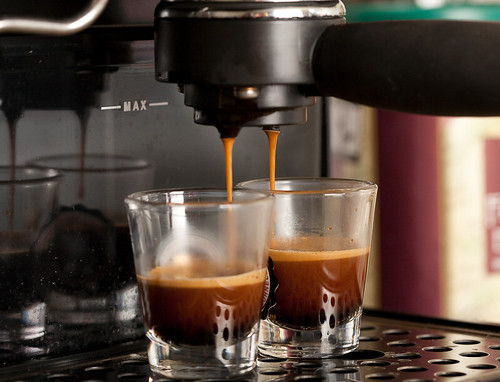For the espresso maker, I bought a Saeco Via Venezia at Costco for $150. It has a pressurized portafilter (the part that holds the coffee) which means it's forgiving of tamp and grind, but on the other hand, doesn't let you diagnose those important attributes, either. You can remove the pressure mechanism (which also seems to make a fake crema) but I found that the gasket needs to remain in place. Here's a picture:

Everything pops apart, and with pressure control removed, it's easy to find deficiencies in technique. I found my cheapo grinder wasn't getting fine enough, so I got a Capresso Infinity grinder that works much better.
Temperature is very important in brewing, and you can find lots of information on adding PID control to the machine. I might do this some time with my Arduino, but for now I measured the temperature profile at the boiler and at the brew head. When the heater kicks off, peak temperature reaches about 100 C just at the mid point of the boiler, and about 105 C where the thermostats are. Just before the heater kicks in, the temperature drops to 80 and 85 C, respectively. I measured the brew temperature below the group by removing the portafilter and using a thermocouple in a styrofoam cup to probe the water temperature. Just after the boiler kicks off, the water is at 90 C, which is just passable for brewing espresso. For now, I brew right after the boiler kicks off. Eventually, the Arduino controlled unit could have forward looking adjustment and hotter temperatures for different roasts.
Tamping and grind control the pace of brewing. With my old grinder, the 'espresso' looked weak, tasted weak, and took only 11 s to brew. You can find a lot of information about tamping and most sites will say use about 30 lbs of force. The Saeco has a 53 mm portafilter, while commercial makers have 58 mm portafilters, so for this maker I settled on 25 lbs as a tamping force. I varied the grind fineness to get 20-25 s for a double shot pull and found that I need to use the finest setting on the grinder.
Two shots pulled using cheap Trader Joe's espresso blend. Tastes much better with good beans...

No comments:
Post a Comment